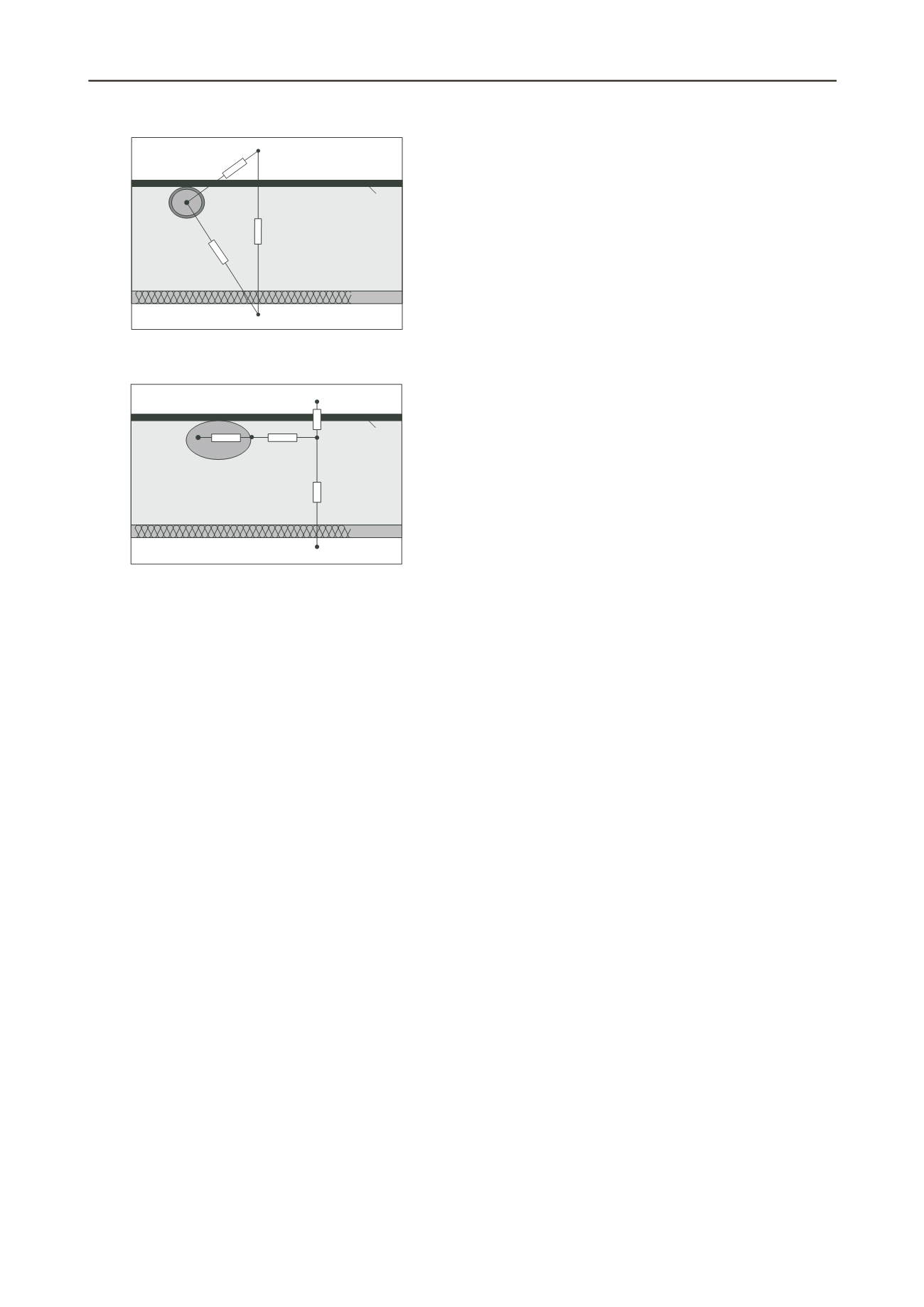
3426
Proceedings of the 18
th
International Conference on Soil Mechanics and Geotechnical Engineering, Paris 2013
T
1
T
2
T
m
Soil
Sealing
Concrete
Insulation
Room
R
3
R
2
R
1
Figure 6. Thermal Resistance Model for the thermo-active seal panel
(triangle mesh)
The thermal activation of earth coupled structures is
principle available for everyone. From the economic point of
view, the boundary conditions (soil type, underground
temperature, contact area, etc) have to be favourable. To
achieve a high efficiency of this systems the heat transfer
between soil and heat exchanger as to be described accurately.
A calculation model for describing the heat transfer for plane
structures between ground and thermo-active structures has
been developed by the Chair of Geotechnical Engineering at
RWTH Aachen University. This model is based on the
combinations of thermal resistances, which is a common
method in geothermal analyses. The model will be implemented
in the software program SHEMAT. After that the calculation
model should be verified by numerical simulations and
calibrated with laboratory tests.
Sealing
Concrete
Insulation
Room
T
1
T
2
T
C
T
W
T
m
R
Pipe
R
X
R
W,1
R
W,2
6 ACKNOWLEDGEMENTS
Figure 7. Thermal Resistance Model for the thermo-active seal panel
(star-network)
The temperature in the heat exchanging pipe is assumed as
an average temperature T
m
between inflow and return flow.
This simplification is very common in geothermal analyses. The
thermal resistances due to the conduction in the pipe and the
convection in the fluid flow are summarized to the resistance of
the pipe R
Pipe
. This leads to the temperature at the pipe wall T
W
.
The research on the utilization of smouldering mining dumps
was funded by the Federal Ministry of Education and Research
(Germany). The work was done in collaboration with Unit of
Technology of fuels (RWTH Aachen University, Germany),
Fraunhofer Institute UMSICHT (Oberhausen, Germany), DMT
– Department of Fire Protection (Dortmund, Germany) and Aix-
o-therm GeoEnergien (Marl, Germany). The development of a
Software tool for the calculation of the heat transfer of plane
structures is funded by Deutsche Bundesstiftung Umwelt
(DBU). This work is done in collaboration with Geophysica
Beratungsgesellschaft mbH (Aachen, Germany) and NAUE
GmbH & Co.KG. Sincere thanks are given to all.
7 REFERENCES
The interaction between the single heat exchanging pipes is
represented by the so called ‘structure resistance’ R
x
. Therefore,
an approach will be taken which is adapted from the calculation
of concrete core activation (see also Koschenz & Dorer 1999).
By solving the differential equation for the heat conduction, the
temperature distribution between two pipes can be determined.
Then, the ‘core temperature” T
C
can be calculated as an integral
of the temperature distribution. In this context, the decisive
parameters will be the pipe distance, the embedded material
(concrete) and the position of the pipe (overlaying material).
Adam D. and Markiewicz R. 2009.
Energy from earth-coupled
structures, foundations, tunnels and sewers.
Géotechnique 59(3),
229-236.
Brandl H. 2006.
Energy foundations and other thermo-active ground
structures
. Géotechnique 56(2), 81-122.
Clauser, C. 2003.
Numerical Simulation of Reactive Flow in Hot
Aquifers. SHEMAT and Processing SHEMAT.
New York, Springer.
Gehlin, S. 2002.
Thermal Response Test – Methods, Development and
Evaluation.
Ph.D. Thesis. Dep. of Environmental Engineering,
Lulea University of Technology, Sweden.
The advantage of this procedure is that all processes which
are connected to the heat exchanging pipes can be summarized
by calculation the core temperature. After calculation the core
temperature the heat flow to both sides of the wall can be
determined by using the well known assumption for the 1D-heat
transfer through a wall. For the numerical coupling this
approach has another advantage. The parameters which are used
in the calculation model are the same values as the transfer
values for SHEMAT (heat flows through both side of the wall
and the resulting temperature at the outside of the wall T
1
and
T
2
respectively).
Hellström, G. 1991. Ground heat storage. Thermal analysis of duct
storage systems. Ph.D. Thesis; Dep. of Mathematical Physics,
University of Lund, Sweden.
Koschenz, M., Dorer, V. 1999.
Interaction of an air system with
concrete core conditioning.
Energy and Building 30, 139-145.
Kürten, S.; Ziegler, M.; Olischläger, V.; Ehrenberg, H. 2012.
Untersuchungen zur Effizienz von thermo-aktiven Abdichtungs-
elementen zur thermischen Nutzung des Untergrunds. In:
Bautechnik 89 (3), p. 192-199.
Kürten, S., Feinendegen, M., Noel, Y., Gaschnitz, R., Schwerdt, P.,
Klein, A. 2010.
Geothermal Utilization of Smouldering Mining
Dumps as a Substitute for Fossil Fuels.
Proceedings of ICCFR2 -
Second International Conference on Coal Fire Research, Berlin,
Germany.
Mottaghy, D. and Dijkshoorn, L. 2012.
Implementing an effective finite
difference formulation for borehole heat exchangers into a heat and
mass transport code.
Renewable Energy 45, 59-71.
5 CONCLUSION AND OUTLOOK
Near Surface Geothermal Energy is a good alternative to satisfy
the heat requirement of buildings. To improve the efficiency of
this renewable energy resource, new systems must be
developed. It was shown that the thermal utilization of
smouldering mining dumps is possible. The limiting factor is
the poor transport inside the dump (due the low thermal
conductivity) which can be compensated by the high
temperature only for a bit. Nevertheless, the thermal utilization
of the smouldering is a good alternative for the owner of the
dump to deal with the smouldering.
Pralle N., Franzius J.N., Acosta F., Gottschalk D. 2009.
Using
Tunneling Concrete Segments as Geothermal Energy Collectors.
Proceedings of the 5th Central European Congress on Concrete
Engineering. Baden, Germany. 137-141.
VDI 4640-2 2009.
Thermal use of the underground – Ground source
heat pump systems
. Beuth-Verlag, Berlin, Germany.


